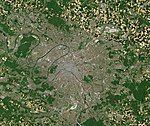Seine (department)
1790 establishments in France1968 disestablishments in FranceEnclaves and exclavesFormer departments of France in FranceStates and territories disestablished in 1968 ... and 1 more
States and territories established in 1790

Seine was the former department of France encompassing Paris and its immediate suburbs. It is the only enclaved department of France at that time. Its prefecture was Paris and its INSEE number was 75. The Seine department was disbanded in 1968 and its territory divided among four new departments: Paris, Hauts-de-Seine, Seine-Saint-Denis and Val-de-Marne.
Excerpt from the Wikipedia article Seine (department) (License: CC BY-SA 3.0, Authors, Images).Seine (department)
Boulevard Saint-Germain, Paris 5th Arrondissement (Paris)
Geographical coordinates (GPS) Address Phone number Website Nearby Places Show on map
Geographical coordinates (GPS)
| Latitude | Longitude |
|---|---|
| N 48.85 ° | E 2.35 ° |
Address
Coffea
Boulevard Saint-Germain 52
75005 Paris, 5th Arrondissement (Paris)
Ile-de-France, France
Open on Google Maps









